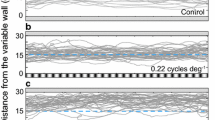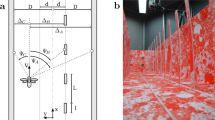Abstract
The wingbeat of an insect relates directly to energy consumption, is a strong indicator of its rate of metabolism and physical structure, and inversely relates to the length of its wing and to the mass of its body. It is also a principal component in understanding the aerodynamic properties of its flight. In this paper, we introduce a method based on the use of high-speed cameras and computer vision techniques to analyze a bumblebee (Bombus impatiens) wingbeat. We start capturing images with a virtual stereo system when a bumblebee crosses two intersecting laser beams. Then, we detect moving objects using background subtraction. Next, via Fourier analysis of the observed optical flow contraction/expansion, and marginalization of prior knowledge, we estimate the wingbeat frequency. Finally, the information from the two virtual cameras is fused using a robust state estimation. Our system is well prepared to handle occlusions; it works with untethered insects; and it does not require the synchronization of a multi-camera system.


Similar content being viewed by others
References
Atanbori J, Cowling P, Murray J, Colston B, Eady P, Hughes D, Nixon I, Dickinson P (2013) Analysis of bat wing beat frequency using Fourier transform. In: Wilson R, Hancock E, Bors A, Smith W (eds) Computer analysis of images and patterns, pp 370–377. Springer, Berlin
Bergou A, Swartz S, Breuer K, Taubin G (2011) 3D reconstruction of bat flight kinematics from sparse multiple views. In: IEEE international conference on computer vision workshops, pp 1618–1625. IEEE
Casey T, Michael M, Morgan K (1985) Flight energetics of euglossine bees in relation to morphology and wing stroke frequency. J Exp Biol 116(1):271–289
Cochran W, Bowlin M, Wikelski M (2008) Wingbeat frequency and flap-pause ratio during natural migratory flight in thrushes. Integr Comp Biol 48(1):134–151
Deakin M (2010) Formulae for insect wingbeat frequency. J Insect Sci 10(1):1–9. doi:10.1673/031.010.9601
Dudley R, Ellington C (1990) Mechanics of forward flight in bumblebees: I. Kinematics and morphology. J Exp Biol 148(1):19–52
Farnebäck G (2003) Two-frame motion estimation based on polynomial expansion. In: Bigun J, Gustavsson T (eds) Image analysis, pp 363–370. Springer, Berlin
Fontaine E, Zabala F, Dickinson M, Burdick J (2009) Wing and body motion during flight initiation in Drosophila revealed by automated visual tracking. J Exp Biol 212(9):1307–1323
Fry S, Sayaman R, Dickinson M (2003) The aerodynamics of free-flight maneuvers in Drosophila. Science 300(5618):495–498
Graetzel F, Fry S, Nelson B (2006) A 6000 Hz computer vision system for real-time wing beat analysis of Drosophila. In: International conference on biomedical robotics and biomechatronics, pp 278–283. IEEE
Isard M, Blake A (1998) Condensation: conditional density propagation for visual tracking. Int J Comput Vis 29(1):5–28
Jacobsen E, Lyons R (2003) The sliding DFT. Signal Process Mag IEEE 20(2):74–80
Jantzen B, Eisner T (2008) Hindwings are unnecessary for flight but essential for execution of normal evasive flight in Lepidoptera. Proc Natl Acad Sci 105(43):16636–16640
Kalman R (1960) A new approach to linear filtering and prediction problems. J Basic Eng 82(1):35–45
Koehler C, Liang Z, Gaston Z, Wan H, Dong H (2012) 3D reconstruction and analysis of wing deformation in free-flying dragonflies. J Exp Biol 215(17):3018–3027
McQuarrie D (2000) Statistical mechanics. University Science, Sausalito
Mountcastle A, Combes S (2013) Wing flexibility enhances load-lifting capacity in bumblebees. Proc R Soc B Biol Sci 280(1759):1–8. doi:10.1098/rspb.2013.0531
Pennycuick C (2001) Speeds and wingbeat frequencies of migrating birds compared with calculated benchmarks. J Exp Biol 204(19):3283–3294
Prince S (2012) Computer vision: models, learning, and inference. Cambridge University Press, Cambridge
Pringle J (1949) The excitation and contraction of the flight muscles of insects. J Physiol 108(2):226–232
Roberts S, Harrison J (1998) Mechanisms of thermoregulation in flying bees. Am Zool 38(3):492–502
San N, Truong Q, Goo N, Park H (2013) Relationship between wingbeat frequency and resonant frequency of the wing in insects. Bioinspir Biomim 8(4):046008
Sane S, Jacobson N (2006) Induced airflow in flying insects II. Measurement of induced flow. J Exp Biol 209(1):43–56
Serra J (1986) Introduction to mathematical morphology. Comput Vis Graph Image Process 35(3):283–305
Sotavalta O (1952) Flight-tone and wing-stroke frequency of insects and the dynamics of insect flight. Nature 170(4338):1057–1058
Sotavalta O (1953) Recordings of high wing-stroke and thoracic vibration frequency in some midges. Biol Bull 104(3):439–444
Steen R (2014) The use of a low cost high speed camera to monitor wingbeat frequency in hummingbirds (Trochilidae). Ardeola 61(1):111–120
Sudo S, Tsuyuki K, Kanno K (2005) Wing characteristics and flapping behavior of flying insects. Exp Mech 45(6):550–555
Sun M, Xiong Y (2005) Dynamic flight stability of a hovering bumblebee. J Exp Biol 208(3):447–459
Unwin D, Ellington C (1979) An optical tachometer for measurement of the wing-beat frequency of free-flying insects. J Exp Biol 82(1):377–378
van Roy J, De Baerdemaeker J, Saeys W, De Ketelaere B (2014) Optical identification of bumblebee species: effect of morphology on wingbeat frequency. Comput Electron Agric 109:94–100
Vanderplank FL (1950) Air-speed/wing-tip speed ratios of insect flight. Nature 165:806–807. doi:10.1038/165806a0
Zeng L, Hao Q, Kawachi K (2000) A scanning projected line method for measuring a beating bumblebee wing. Optics Commun 183(1):37–43
Zhang G, Sun J, Chen D, Wang Y (2008) Flapping motion measurement of honeybee bilateral wings using four virtual structured-light sensors. Sens Actuators A Phys 148(1):19–27
Zivkovic Z (2004) Improved adaptive Gaussian mixture model for background subtraction. In: International conference on pattern recognition, vol 2, pp 28–31. IEEE
Zivkovic Z, van der Heijden F (2004) Recursive unsupervised learning of finite mixture models. IEEE Trans Pattern Anal Mach Intell 26(5):651–656
Zivkovic Z, van der Heijden F (2006) Efficient adaptive density estimation per image pixel for the task of background subtraction. Pattern Recognit Lett 27(7):773–780
Acknowledgments
This work was partially funded by SIP-IPN under contract 20140325, and Fomix CONACYT-GDF under Grant 189085.
Author information
Authors and Affiliations
Corresponding author
Rights and permissions
About this article
Cite this article
Santoyo, J., Azarcoya, W., Valencia, M. et al. Frequency analysis of a bumblebee (Bombus impatiens) wingbeat. Pattern Anal Applic 19, 487–493 (2016). https://doi.org/10.1007/s10044-015-0501-3
Received:
Accepted:
Published:
Issue Date:
DOI: https://doi.org/10.1007/s10044-015-0501-3




